Uncategorized
The Jewish Museum has just completed a major renovation. Here are 7 highlights.
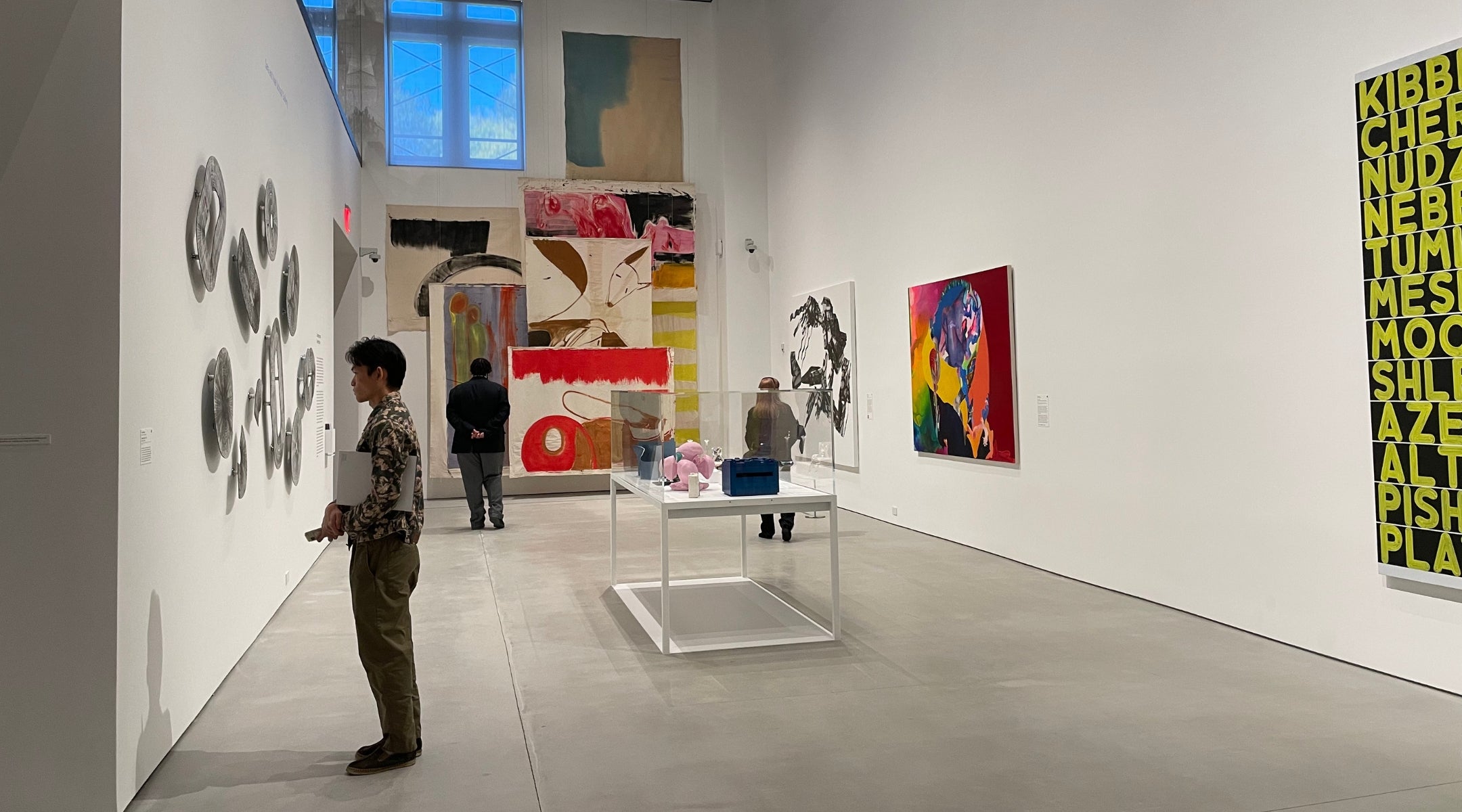
Following a yearlong, $14.5 million renovation, the Jewish Museum — which is housed a 1908 French Gothic mansion on Fifth Avenue — is opening two upgraded floors to the public.
Among the new features on the museum’s reimagined third and fourth floors: a new installation, “Identity, Culture and Community: Stories from the Collections of the Jewish Museum,” which spotlights 200 items from the museum’s permanent collection; four galleries for rotating exhibits and new acquisitions and the Pruzan Family Center for Learning, featuring art-making studios, a touch wall, and an interactive, simulated archaeological dig.
The renovation is the brainchild of the museum’s director, James Snyder, who assumed the helm of the 121-year-old institution in November 2023, following stints as the director of the Israel Museum and deputy director of the Museum of Modern Art in New York.
The renovation “gave us the opportunity to think through an entirely new narrative, an entirely new strategy for what we are all about,” Snyder said during a press event on Tuesday.
“These are complex times — they have been for a while. They’re getting more and more complex every day,” Snyder said. “Our job, particularly for culturally specific museums like this one, is to be the antidote to what’s really a pandemic today — to the xenophobia, the racism, the ignorance that is prevalent everywhere now.”
Here are seven things to see and do at the renovated Jewish Museum’s new galleries.
1. Marc Chagall’s “Self-Portrait with Palette” (1917)
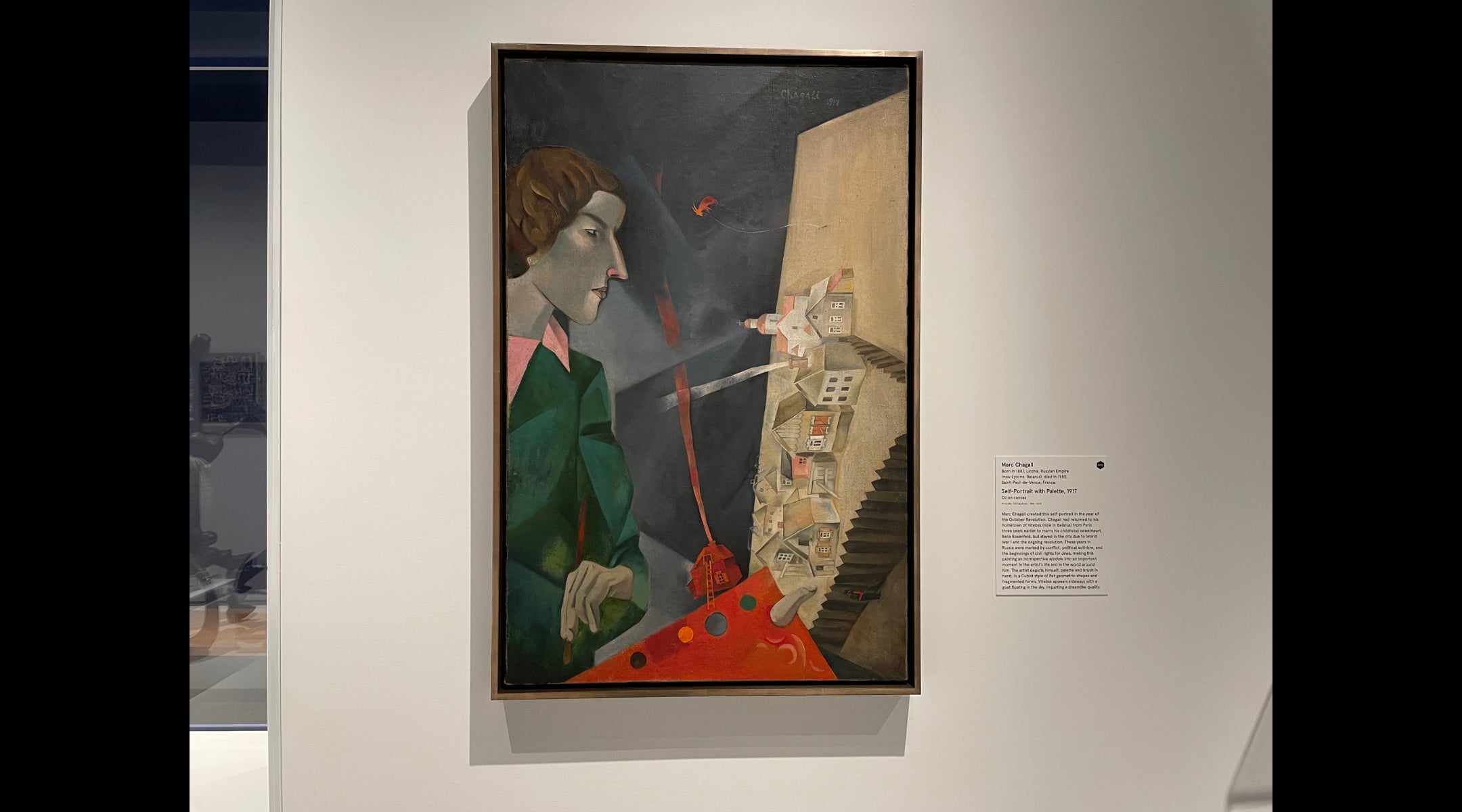
Marc Chagall’s “Self-Portrait with Palette” (1917) is among the new acquisitions at the Jewish Museum. (Jackie Hajdenberg)
This self-portrait by the lauded Jewish artist is in the Cubist style. An oil on canvas, the painting shows Chagall as a young man holding a brush and palette, with his hometown of Vitebsk (in today’s Belarus) in the background.
When the portrait was painted — during the Russian Revolution — Chagall had just returned home after three years at a Parisian art school in order to marry his childhood sweetheart, Bella Rosenfeld, who modeled for many of his works.
The painting, a new acquisition by the museum, was previously in a private collection. It was last publicly exhibited at the Tefaf New York art fair at the Park Avenue Armory in 2022. It hangs “in conversation” with a newly acquired piece by Alice Neel, titled “Nazis Murder Jews,” from 1936, an unusually non-abstract work by Mark Rothko that shows a deconstructed crucifix, and three paintings by Romanian-Israeli painter Reuven Rubin.
2. 130+ Hanukkah lamps, from ancient times to the present

A glass case of more than 130 Hanukkah lamps is part of the Jewish Museum’s identity and culture exhibit, drawn from the museum’s collection. (Jackie Hajdenberg)
The Jewish Museum has more than 1,400 Hanukkah menorahs in its collection, and as part of its new, fourth-floor learning center, more than 130 are on display in a space that is open to a double-height gallery on the third floor.
The installation — featuring menorahs from across the globe, antiquity to the present day — is meant to accentuate “the central meaning of light as a symbol of enlightenment and hope across cultures,” per a press release.
Particular highlights include oil lamps from the 2nd to 1st century BCE, as well as a “Menurkey” — a turkey-shaped menorah, devised by 9-year-old Asher Weintraub in 2013, when Thanksgiving and Hanukkah overlapped for the first time since 1888.
3. “The Return of the Volunteer from the Wars of Liberation to His Family Still Living in Accordance with Old Customs” (1833–34) by Moritz Daniel Oppenheim
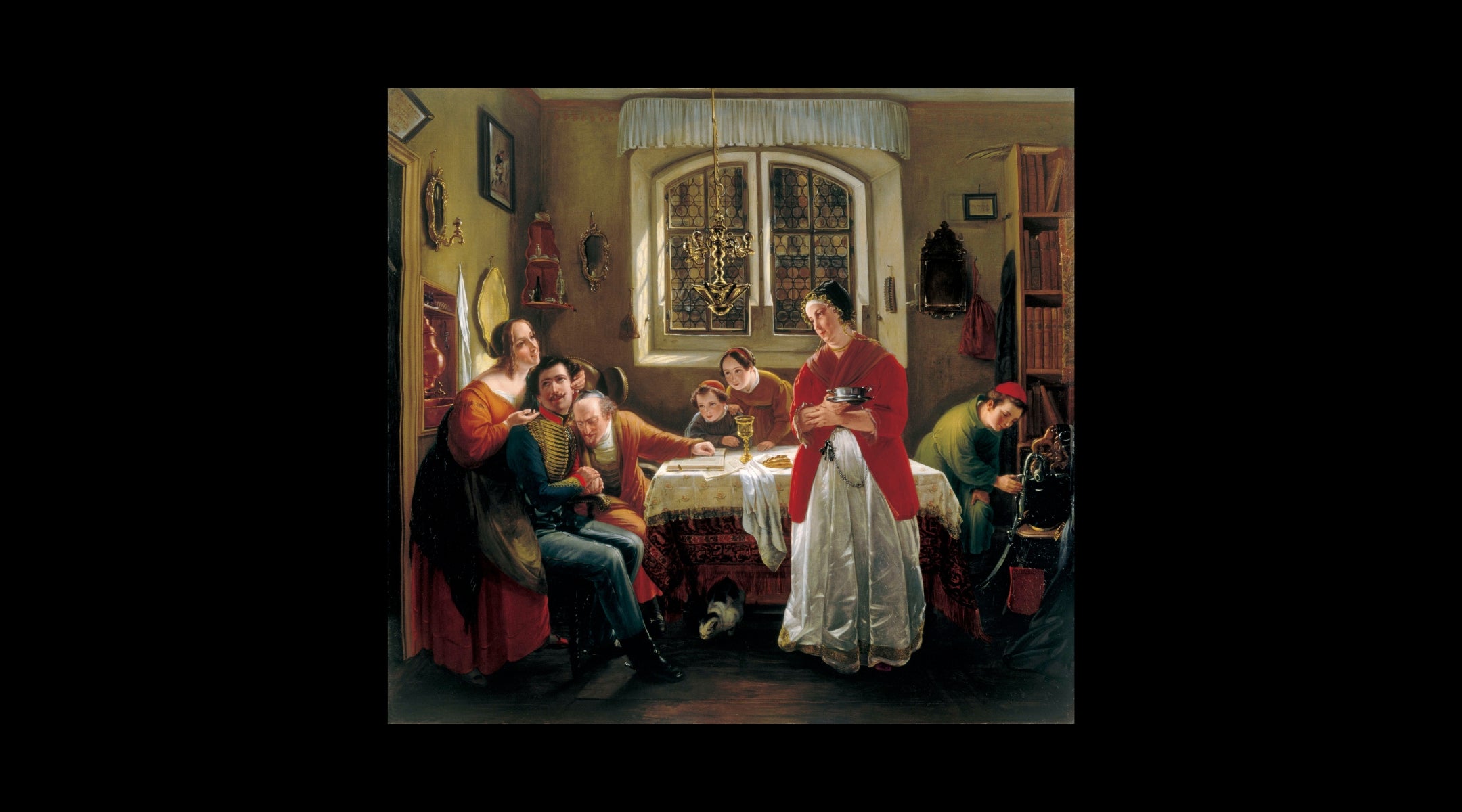
‘The Return of the Volunteer from the Wars of Liberation to His Family Still Living in Accordance with Old Customs” by Moritz Daniel Oppenheim. (Courtesy The Jewish Museum)
Considered to be the first Jewish painter in the modern era, Moritz Daniel Oppenheim — born in 1800 in Hanau, Germany — is known for being the first Jew to receive a formal arts education in Europe.
Many of Oppenheim’s works — which are on view at the museum as part of its permanent collection — showcase intimate portraits of Jewish life in Europe. Considered his masterpiece, “The Return of the Volunteer,” depicts a young German Jewish man returning home after helping defend Germany against the Napoleonic armies just as his family is welcoming Shabbat. (Note the challah and kiddush cup on the table.)
Oppenheim created the painting during a time of civil unrest following the 1830 revolutions in France, when some German states passed repressive legislation against the Jews. Per the Jewish Museum, “This painting has been interpreted as a reminder to Germans of the significant role played by Jews in the Wars of Liberation, and its political overtones are unusual in the generally apolitical nature of Biedermeier art.”
4. Letters between George Washington and Moses Seixas
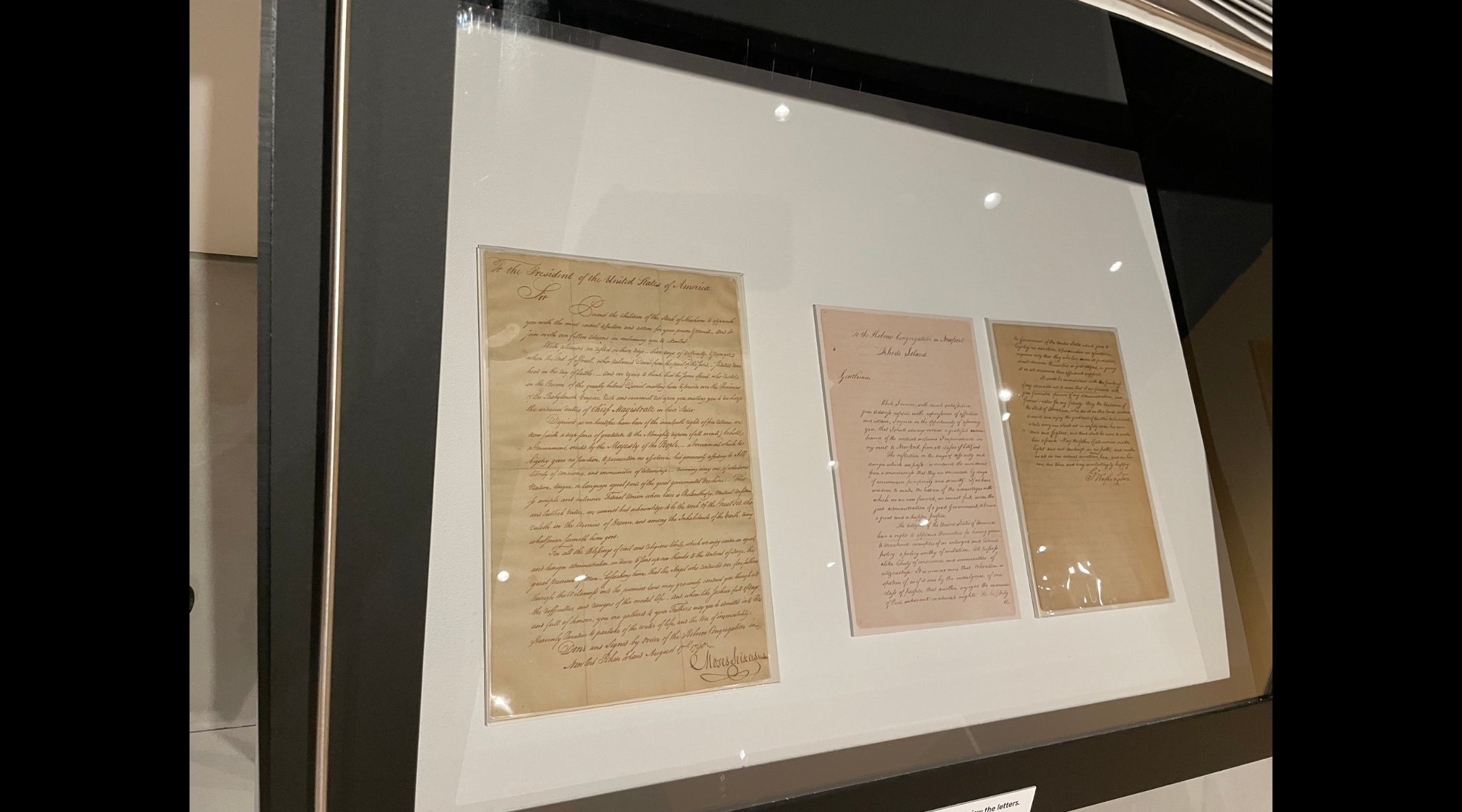
A letter exchange between Touro Synagogue president Moses Seixas and American President George Washington. (Jackie Hajdenberg)
Part of the new “Identity, Culture and Community” exhibit is a section on Jews in the Colonial Era. A highlight here are letters from 1790 between new American President George Washington and Moses Seixas, the president of Jeshuat Israel of Newport, Rhode Island, now known as the Touro Synagogue — the oldest synagogue in the United States.
Washington came to Rhode Island after the state ratified the United States Constitution in order to promote the passing of the Bill of Rights; upon Washington’s arrival in Newport, Seixas read a letter aloud to the president, in which he expressed optimism at the freedom of religion that Americans would see in this new country.
“May the children of the stock of Abraham who dwell in this land continue to merit and enjoy the good will of the other inhabitants —,” Washington wrote in response, adding a quotation from scripture, “while everyone shall sit in safety under his own vine and fig tree and there shall be none to make him afraid.”
The letters are so delicate they’re kept under a window blind that visitors manually pull up and down, to minimize exposure to light.
5. A child-friendly mock archaeology dig
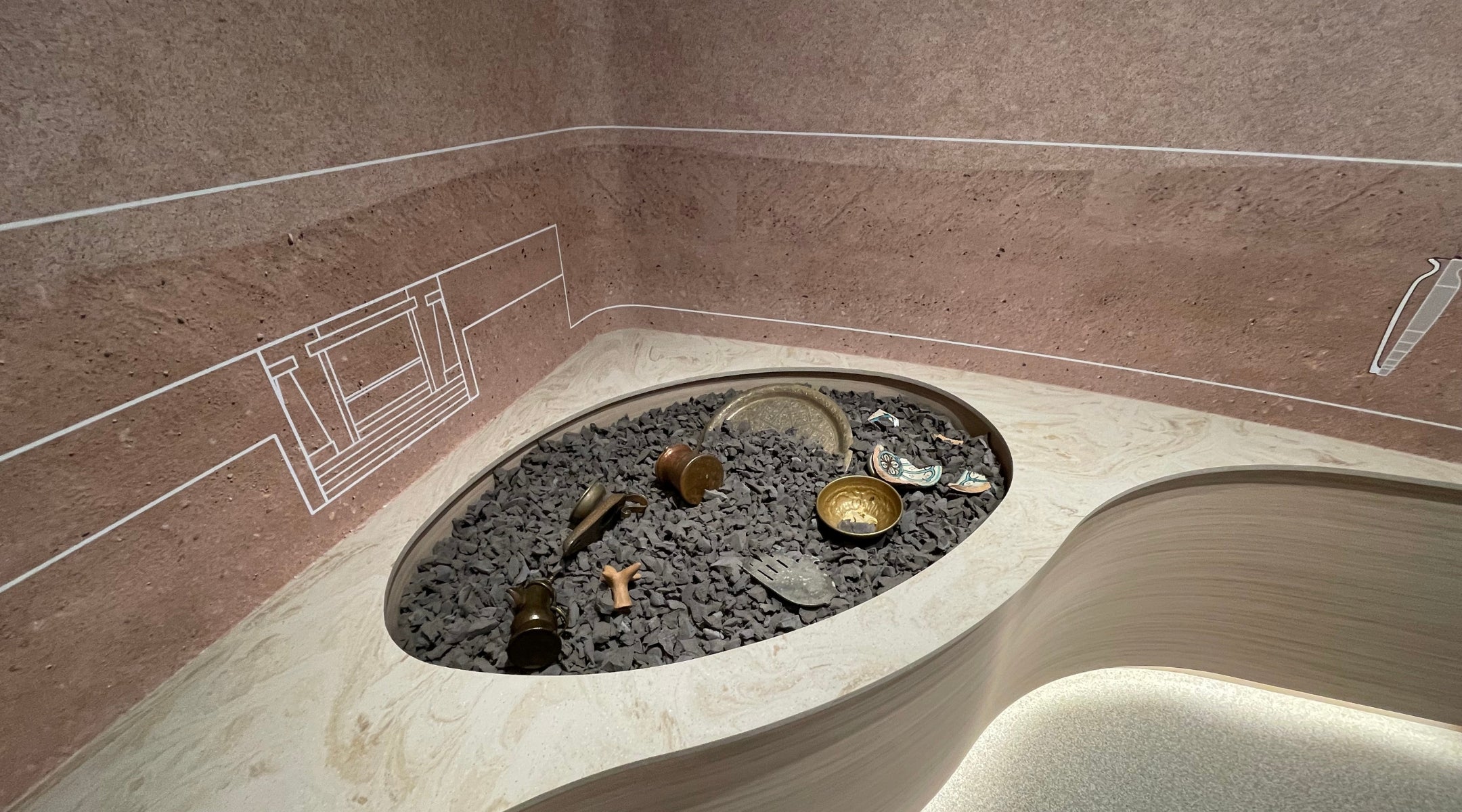
Visitors of all ages can dig for replicas of real ancient artifacts in the Jewish Museum’s newly renovated dig room. (Jackie Hajdenberg)
As part of the Pruzan Family Center for Learning, the Jewish Museum’s new mock archeology dig is three times larger than the previous version. Here, as part of the visitors can dig through four pits, each centered around a different era in time, for replicas of real artifacts, such as an Ottoman-era copper alloy coffeepot from Jerusalem, an ancient Roman oil lamp and a calcite-alabaster jar from ancient Egypt circa 1550 BCE.
The real versions of those artifacts — most of them newly on display in the room — are also on display, accompanied by kid-friendly language. Families are provided with an “Archaeologist’s Notebook” to keep track of their finds.
6. “in full command of every plan you wrecked” (2024) by Zoë Buckman
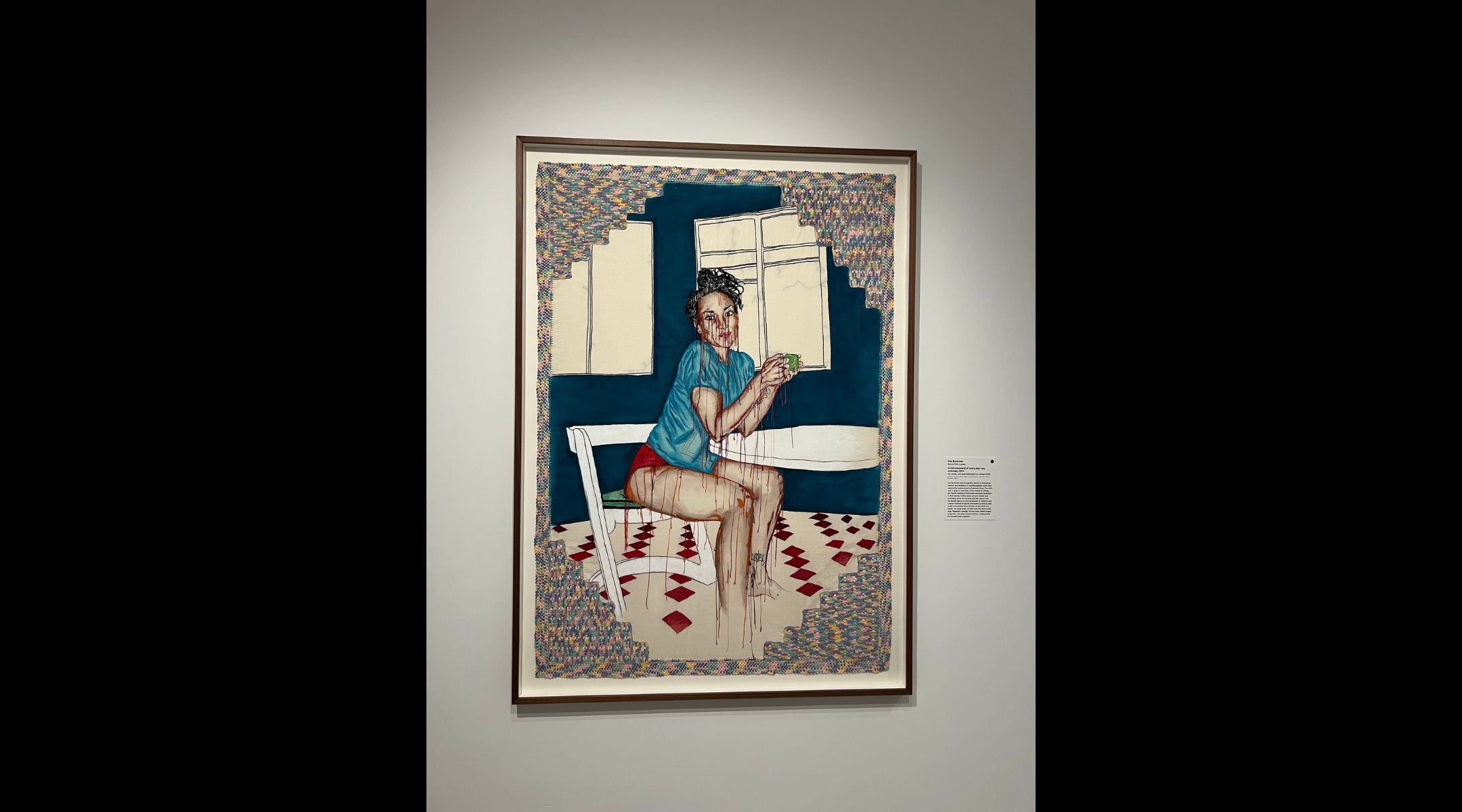
“in full command of every plan you wrecked” by Zoë Buckman is on view at the Jewish Museum as part of the third floor’s rotating exhibitions. (Jackie Hajdenberg)
Zoë Buckman, 40, is a British Jewish artist whose work has been featured in the UK’s National Portrait Gallery and who has emerged as a prominent voice among artists on antisemitism in the wake of the Gaza war. This ink, acrylic and hand-embroidered piece is Buckman’s debut at the Jewish Museum, which is part of her “Who by Fire” series exploring Jewish personhood.
Located on a third-floor gallery, Buckman’s work depicts a woman sitting on a chair; the piece’s name, “in full command of every plan you wrecked,” a reference to a Leonard Cohen lyric from “Alexandra Leaving.” The loose threads — typically found on the back of such woven pieces — subvert expectations of traditional feminine and domestic textile work.
7. A retrospective on the early works of Anish Kapoor
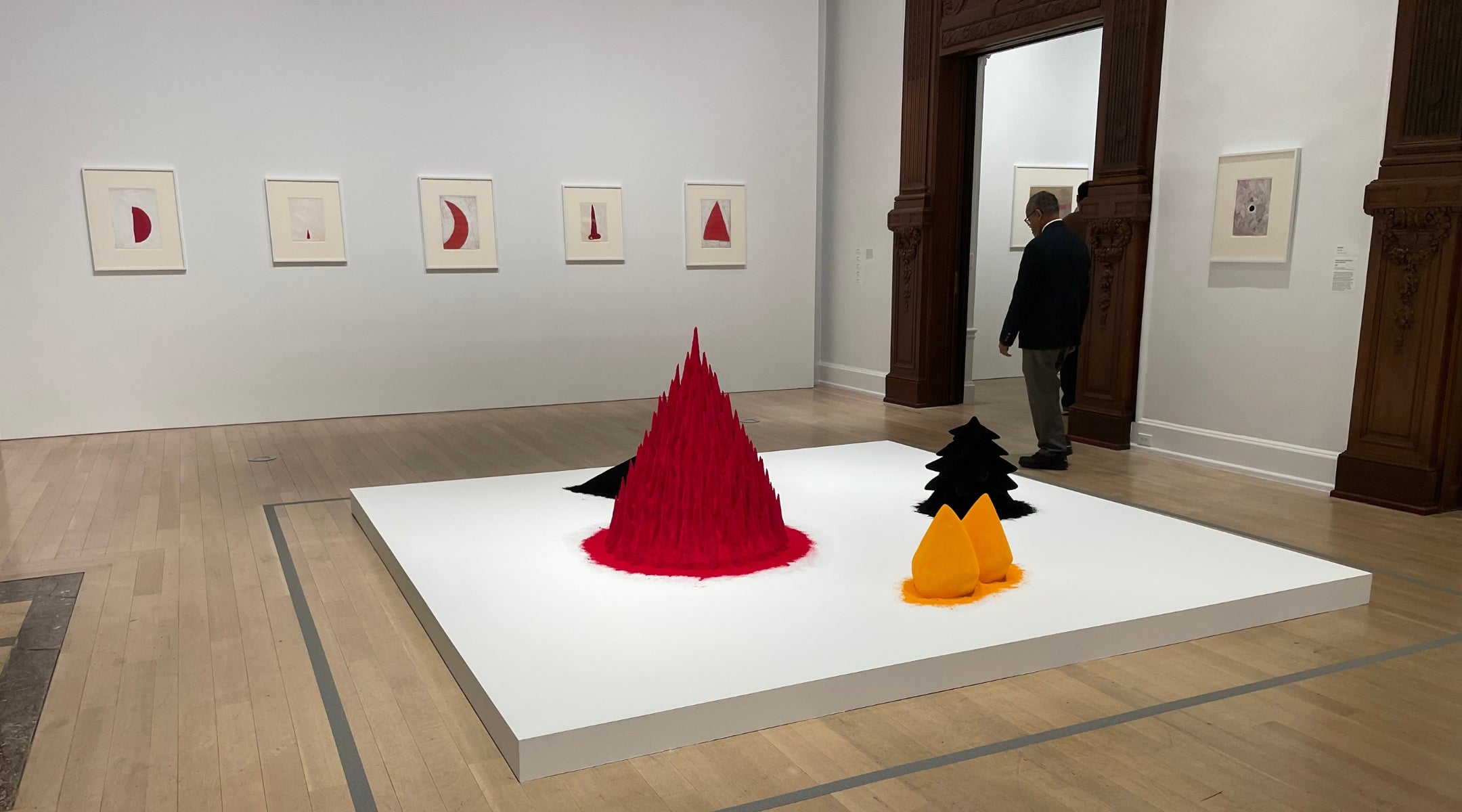
Some of the early sculptural pigment works of Anish Kapoor at the Jewish Museum. (Jackie Hajdenberg)
Born in India in 1954 to a Punjabi Hindu father and an Iraqi Jewish mother from Mumbai, Anish Kapoor rose to prominence as an artist exploring matter, non-matter, space and voids. “Anish Kapoor: Early Works,” on view until Feb. 26, 2026, is the first American museum presentation showcasing Kapoor’s works from the late 1970s and early 1980s, “when he was still the classic starving artist,” per the New York Times.
Snyder and Kapoor — a winner of the prestigious Genesis Prize — have previously collaborated on exhibits at MoMA and the Israel Museum; the Jewish Museum exhibit opens on Friday alongside the museum’s newly reimagined floors. “He is about this narrative of the experience of the Diaspora and what it does to artists,” Snyder said of Kapoor.
—
The post The Jewish Museum has just completed a major renovation. Here are 7 highlights. appeared first on Jewish Telegraphic Agency.
Uncategorized
StopAntisemitism names Tucker Carlson ‘Antisemite of the Year’ as 2024 winner Candace Owens ramps up anti-Jewish rhetoric
(JTA) — The activist group StopAntisemitism has awarded the conservative personality Tucker Carlson its ignominious honor of “Antisemite of the Year,” citing his frequent invocation of classic antisemitic stereotypes.
The announcement comes as Carlson sits at the center of controversy on the American right about whether extremists should be welcomed in the Republican Party. It also marks the second year in a row that StopAntisemitism has selected a right-wing figure for its accolade, after years of awarding the mantle to mostly left-wing figures.
“Carlson mainstreams antisemitism by platforming and praising Holocaust revisionists and Nazi apologists, while hiding behind irony and plausible deniability,” the group said in a statement. “By legitimizing extremist voices and weaponizing conspiratorial imagery at massive scale, he has helped drag antisemitic ideas back into the mainstream.”
A watchdog presence with more than 300,000 followers on X, StopAntisemitism regularly mobilizes against activists and social media posts. The group has faced criticism for what some perceive as an inordinate focus on Muslim personalities, pro-Palestinian actions and non-prominent individuals. Its defenders deny that, pointing out that StopAntisemitism also regularly spotlights neo-Nazis and Holocaust deniers on the right.
Its finalists for Antisemite of the Year included pro-Palestinian celebrities Ms. Rachel, Cynthia Nixon and Marcia Cross; mixed-martial-arts athlete and Holocaust denier Bryce Mitchell; two personalities associated with left-wing network The Young Turks; and social media personalities on both the far left (Guy Christensen) and far right (Stew Peters).
Carlson received the accolade on Sunday night, at the end of a weekend in which he was a keynote speaker at the convention of Turning Point USA, the young-conservatives group founded by Charlie Kirk, who was assassinated this fall. In its announcement, StopAntisemitism noted Carlson’s speech at Kirk’s memorial service, in which he described the murder of Jesus in a way that both his critics and fans interpreted as implying that Jews or Israelis had been behind Kirk’s assassination.
At the convention, the Jewish pundit Ben Shapiro continued his campaign against Carlson and Carlson declared himself to free of the anti-Jewish animus that he has long been criticized as propagating.
“Let me just affirm one final time. Not only am I not an antisemite — and I would say so if I was — I’m not an antisemite for a very specific reason,” Carlson said in his speech. “Not because it’s unpopular or my donors don’t like it. I don’t have any donors. I’m not an antisemite because anti-semitism is immoral in my religion. It is immoral to hate people for how they were born.”
It was the same explanation that Vice President JD Vance offered earlier this month when he said in an NBC News interview that he believed antisemitism is wrong.
In his own speech to Turning Point USA’s AmericaFest, Vance again refrained from criticizing extremists in the Republican Party, saying that he opposes “purity tests” for inclusion in the conservative movement. He also said he believed that antisemitism in the United States was being fueled by “a real backlash” against U.S. aid to Israel..
As the convention was underway, last year’s “Antisemite of the Year,” the right-wing streamer Candace Owens, embarked on a four-hour broadcast eviscerating Shapiro; amplifying antisemitic theories, including that Jews controlled the slave trade; and promoting a classic work of antisemitism by August Rohling, a German Catholic who believed in the blood libel and argued that the Talmud is a secret guide used by Jews for nefarious purposes. Rohling died in 1931.
The post StopAntisemitism names Tucker Carlson ‘Antisemite of the Year’ as 2024 winner Candace Owens ramps up anti-Jewish rhetoric appeared first on The Forward.
Uncategorized
Senior Hamas Official Vows Terror Group Will Never Disarm, Rejects Foreign Pressure

Hamas official Osama Hamdan speaks during a press conference, amid the ongoing conflict between Israel and Hamas, in Beirut, Lebanon, June 4, 2024. Photo: REUTERS/Mohamed Azakir
Hamas has once again rejected calls to disarm, warning against “foreign interference in Palestinian affairs” as the terrorist group’s senior officials met with Turkish leaders to discuss the next phase of the US-backed peace plan for Gaza.
In an interview with the Yemeni news outlet Al-Masirah on Tuesday, Hamas Political Bureau member Osama Hamdan reiterated that the Islamist group will never hand over its weapons to foreign powers.
“The resistance rejects any foreign attempt to disarm us or seize the weapons the occupation failed to take,” the terrorist leader said. “The idea of surrendering our arms is one the resistance will never accept.”
“In the second phase of the Gaza agreement, the guarantees must be clearer, and the commitments more detailed,” Hamdan continued. “The Zionist enemy does not abide by the agreement. Israel’s failure to open the [humanitarian] crossings signals its intention to resume aggression against the Gaza Strip.”
On Wednesday, senior Hamas officials met with Turkish Foreign Minister Hakan Fidan in Ankara to discuss the ongoing ceasefire and coordinate the next steps in advancing the second phase of US President Donald Trump’s peace plan to end the two-year conflict.
“The Americans want to impose hegemony on the region, with the Zionist entity [Israel] as its foundation,” Hamdan said during the interview. “Disarming the resistance would give Israel absolute control over the entire region.”
“The resistance is capable of continuing the fight, and I am confident the outcome of this conflict will be the demise of this entity,” he continued.
According to media reports, Hamas officials told Turkish counterparts they had fulfilled their ceasefire commitments, but accused Israel of violating the deal while blocking progress to the next phase of the agreement.
Since the start of the ceasefire in October, both sides have repeatedly accused each other of violations. Israel has carried out several operations targeting terrorist operatives as the Palestinian group ramps up efforts to reassert control over the war-torn enclave.
According to the US-backed peace plan, the second phase is expected to establish an interim administrative authority — a so-called “technocratic government” — deploy an International Stabilization Force (ISF) to take over security in Gaza, and begin the demilitarization of Hamas.
However, efforts to advance the ceasefire deal have stalled, with no agreement on crucial next steps, including the start of reconstruction in the enclave and the deployment of the ISF.
Turkey, a longtime backer of Hamas, has been trying to expand its role in Gaza’s post-war reconstruction efforts, which experts warn could potentially strengthen Hamas’s terrorist infrastructure.
While Turkey insists on participating in the ISF, Israeli officials have repeatedly rejected any Turkish involvement in post-war Gaza.
Turkey has even sought to shield Hamas from disarmament by pushing for the terrorist group to hand over its weapons to the Palestinian Authority or place them in secure international storage, rather than requiring it to disarm.
Israeli officials have rejected these options as unacceptable, arguing they would allow the terrorist group to maintain its influence in Gaza, which Hamas has ruled for nearly two decades.
Under phase one of Trump’s peace plan, Hamas was required to release all remaining hostages, both living and deceased, who were kidnapped by Hamas-led Palestinian terrorists during the group’s invasion of and massacre across southern Israel on Oct. 7, 2023.
In exchange, Israel freed thousands of Palestinian prisoners, including many serving life sentences for terrorism, and partially withdrew its military forces in Gaza to a newly drawn “Yellow Line,” roughly dividing the enclave between east and west.
According to the ceasefire plan, the Israeli army is required to withdraw further as the disarmament process unfolds. However, Israel has made clear that it will not pull back until Hamas disarms and other conditions are met.
Currently, the Israeli military controls 53 percent of Gaza’s territory, and Hamas has moved to reestablish control over the other 47 percent. However, the vast majority of the Gazan population is located in the Hamas-controlled half, where the Islamist group has been imposing a brutal crackdown.
Since the ceasefire took effect two months ago, Hamas has targeted Palestinians who it labeled as “lawbreakers and collaborators with Israel,” sparking widespread clashes and violence as the group moves to seize weapons and eliminate any opposition.
Uncategorized
US Considers Sanctions on Spain for Barring Ships Bringing Arms to Israel

Containers are seen in the Port of Vigo, Spain, March 13, 2025. Photo: REUTERS/Nacho Doce
The US is weighing potential penalties against Spanish-linked shipping after Spain denied port entry to cargo vessels transporting US weapons to Israel, escalating a rare maritime and diplomatic dispute between two NATO allies.
The Federal Maritime Commission (FMC), an independent agency of the US government, opened an investigation late last year into Spain for refusing to allow at least three cargo vessels — two of which were US-flagged — into its ports.
Two of the three incidents from 2024 noted by the commission involved vessels run by the Danish shipping giant Maersk in November. The other occurred in May, when Spanish officials said they refused permission for the Danish Marianne Danica ship because it was “carrying weapons to Israel” and added they will not allow ships carrying arms for Israel to stop at its ports moving forward.
Last Friday, the FMC released a brief update on the “restrictive port practices of the government of Spain,” noting that “the policy behind those refusals remains in place.” The update went on to explain that the agency will continue its investigation, which could result in the US fining Spain up to $2.3 million per voyage if the probe concludes that the country has interfered with commerce.
“Based on the information obtained up to this point, it appears that the laws or regulations adopted, followed, or enforced by Spain are likely creating general or special conditions unfavorable to shipping in US foreign trade,” the FMC update stated. “Accordingly, the commission must also examine, and now seeks public input on, what remedial actions may be appropriate to meet or adjust those apparent conditions. The commission may weigh a range of potential remedies, including limitations on cargo, refusing entry to vessels operating under Spain’s flag, or imposing fines up to the current inflation-adjusted limit of $2,304,629 per voyage on Spanish-flagged vessels.”
The FMC also posted a more detailed notice, which was published in the Federal Register this week, explaining its concerns with Spain.
In September, Madrid announced “a multi-faceted policy aimed at halting the flow of certain cargo
bound for or coming from Israel through air or marine transport,” the agency explained. “Measures it announced include banning ships and aircraft carrying weapons bound for Israel or tankers carrying fuel for use by the Israeli military from using Spanish ports and airspace.”
The agency went on to outline some of the actions it can take to combat actions it described as creating “unfavorable” conditions for US shipping.
“Remedies the commission can implement to adjust or meet unfavorable conditions to shipping in the foreign trade of the United States include adopting regulations restricting voyages to or from US ports, imposing per voyage fees, limiting amounts or types of cargo, or taking ‘any other action the commission finds necessary and appropriate to adjust or meet any condition unfavorable to shipping the foreign trade of the United States,’” the FMC said.
Spain has been one of the fiercest critics of Israel since the Palestinian terrorist group Hamas’s Oct. 7, 2023, invasion of and massacre across south Israel, amid the ensuing war in Gaza.
In one of its recent attempts to curb Israel’s defensive campaign against Hamas, Madrid decided to block US military planes and ships from using Spanish bases to transport weapons and equipment to Jerusalem.
Spain also unveiled an arms embargo and a ban on certain Israeli goods earlier this year. The Spanish government announced it would bar entry to individuals involved in what it called a “genocide against Palestinians,” block Israel-bound ships and aircraft carrying weapons from Spanish ports and airspace, and enforce an embargo on products from Israeli communities in the West Bank.
Spain has additionally canceled a €700 million ($825 million) deal for Israeli-designed rocket launchers, as the government conducts a broader review to systematically phase out Israeli weapons and technology from its armed forces.
“It is deeply concerning that Spain, a NATO member, has chosen to potentially limit US operations and to turn its back on Israel on the same day six individuals were killed in Jerusalem. These measures embolden terrorists,” a US State Department spokesperson told Reuters in September, on the same day as a Palestinian terrorist attack targeting Israelis.
Last December, FMC commissioner Louis Sola argued that Spain’s actions have a negative effect on the global system of trade, not just Israel.
“Disruptions to international trade systems not only threaten global shipping networks, but also compromise the consumer markets they support. As a member of the international maritime community, Spain is obligated to adhere to international maritime norms,” Sola said. “Reports that the government of Spain has denied access to certain US-flagged vessels raise serious concerns. Section 19 of the Merchant Marine Act, 1920, 46 U.S.C. § 42101, authorizes the commission to identify and offset unfavorable shipping conditions in US foreign trade that result from the laws or regulations of a foreign government.”

